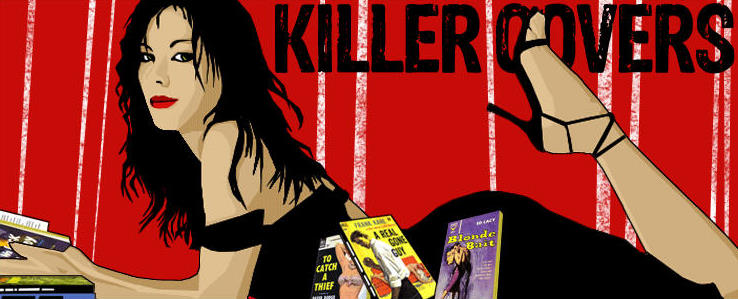

Incredible as this seems, it was two years ago today that
I launched the Killer Covers blog. I’d originally intended this as a pretty basic site, a place where I could explain a bit more about classic crime-novel fronts I was showcasing in the right-hand column of
The Rap Sheet. But Killer Covers grew quickly, and began taking up more and more of my already insufficient free time.
It was all my own damn fault, of course: I was interested in discovering and writing more about the authors and artists whose work I displayed. I didn’t want to simply compose extended captions about each book face, or put up the book covers without any explanation, the way several other blogs already do. At some point last year, however, I realized that I couldn’t possibly keep up with a weekly schedule of Killer Covers posts, if they were all to be 1,500 or more words in length. So I started to trim back my expectations, eventually excusing myself for not updating the blog for a week or two at a time, because I didn’t have enough energy and extra hours to write everything I wanted.
During this last holiday season, I started to rethink the mission of Killer Covers. I accepted the fact that, since nobody is paying me to write the blog, I can’t devote my full time to it. I already over-schedule myself by trying to keep up The Rap Sheet and my third blog,
Limbo--in addition to doing work that puts food on my table. I finally decided that Killer Covers should do more than host protracted posts about prominent 20th-century illustrators and authors whose work has often been forgotten. So from now on, you should see more brief and newsier postings here, focusing on cover-related developments in the crime-fiction world and pointing you toward book-design material appearing in other blogs. I won’t give up penning thorough articles about justly lauded artists such as
Norman Saunders and
Ernest “Darcy” Chiriacka, or novelists the likes of
Talmage Powell and
William Ard. And there are two or three interviews I’m hoping to post here in the near future. But I can’t
only do time-consuming, comprehensive reports.
By the way, I have made another change in Killer Covers, as well. Elements of the right-hand column have been reordered. Near the top you’ll now find a selection of links to “Classic Cover Art Resources,” Web sites to which people (like me) who have a particular interest in learning more about vintage book design and illustrators can go for additional information. Beneath that are two blogrolls, the first featuring sites that spotlight crime fiction as well as other subjects I find fascinating, and a second where I’ve installed connections to blogs that talk primarily about the look of books. The number of sites in each of those blogrolls is limited, but can be easily expanded by hitting the “Show All” tabs at their respective ends.
To all you readers who have followed Killer Covers over the last couple of years, let me offer my sincerest thanks. In honor of this anniversary, and as a small gift, I’ve installed atop this post two more of my favorite classic jackets: The one on the left comes from the 1957 Permabooks edition of
The Golden Widow, by Floyd Mahannah (artwork by
Clark Hulings); the one on the right is taken from the Monarch edition of Fletcher Flora’s
Most Likely to Love, first published in 1960 (with cover illustration by
Rafael DeSoto).























